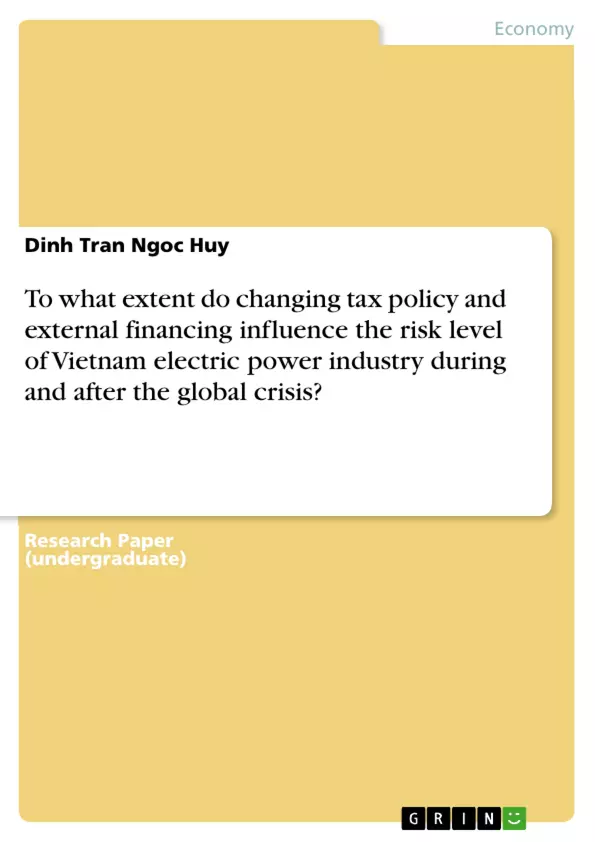Throughout years, electric power industry in Viet Nam has reached a lot of achievements. Under the volatility of stock price, and changes in macro factors such as inflation and interest rates, the well-established electric market in Viet Nam has many efforts to recover and grow from the crisis 2008. This study analyzes the impacts of both tax rate policy and leverage on market risk for the listed firms in the electric power industry as it becomes necessary.
First, by using quantitative and analytical methods to estimate asset and equity beta of total 20 listed companies in Viet Nam electric power industry with a proper traditional model, we found out that the beta values, in general, for many companies are acceptable. Second, under 3 different scenarios of changing tax rates (20%, 25% and 28%), we recognized that there is not large disperse in equity beta values in each scenario of leverage, estimated at 0,032 for current leverage situation. Third, by changing tax rates in 3 scenarios (25%, 20% and 28%), we recognized both equity and asset beta mean values have positive relationship with the increasing level of tax rate.
Finally, this paper provides some outcomes that could provide companies and government more evidence in establishing their policies in governance.
Frequently Asked Questions about the Language Preview
What is the main topic of this preview?
This is a comprehensive language preview which includes the title, table of contents, objectives and key themes, chapter summaries, and key words of a research paper analyzing themes in a structured and professional manner. It appears to focus on financial risk assessment and policy suggestions related to the electric power market in Viet Nam.
What are the main sections covered in the table of contents?
The preview includes the following sections: Introduction, Preliminary Notes (Research Issues, Literature review, Conceptual theories, Methodology), Main Results (General Data Analysis, Empirical Research Findings and Discussion, Comparing statistical results in 3 scenarios of changing leverage), Conclusion and Policy suggestion, Acknowledgements, References, and Appendix.
What are the research issues outlined in the preview?
The preview states the following research issues:
- Whether the risk level of electric power firms under the different changing scenarios of tax rates increase or decrease so much?
- Whether the dispersed distribution of beta values become large in the different changing scenarios of leverage estimated in the electric power industry?
What are some of the conceptual theories mentioned?
The preview mentions the combination of tax rate policy and leverage during crisis periods. It discusses how fiscal and monetary policies (including tax rates) and leverage impact aggregate demand, market growth, tax obligations, revenues, profit, innovation, and compensation within the electric power industry.
What methodology is used in the research?
The methodology involves using data from the stock exchange market in Viet Nam (HOSE and HNX) during the 2007-2011 period to estimate systemic risk. Analytical research methods, specifically tax rate scenario analysis, are employed. The current tax rate used is 25%.
What does the General Data Analysis section cover?
The General Data Analysis section explains the sample has 20 listed firms and their sensitivity with beta values when the tax rate is changed. The sensitivity of tax rate is estimated under 3 scenarios (rate = 20%, 25%, and 28%). It estimates the impact of varying tax rates on asset beta means and variances under financial leverage.
What scenarios are being considered in the Empirical Research Findings and Discussion?
Table 1 outlines three scenarios:
- Scenario 1: Leverage as current.
- Scenario 2: Tax rate up to 30%.
- Scenario 3: Tax rate down to 20%.
What kind of data does the research use?
Data from the stock exchange market in Viet Nam, specifically from listed electric power firms. It included market risk (beta), equity beta, asset beta, and financial leverage.
What do the Exhibits show?
Exhibit 1 shows the VNI Index and other stock market index during crisis 2006-2010. Exhibit 2 compares comparable firms and changing leverage for Viet Nam electric power firms.
What are the policy suggestions?
The policy suggestions are for the government to consider the impacts on market risk when changing macro policies. The Ministry of Finance should increase the effectiveness of fiscal and tax policies combined with other macro policies. The State Bank of Viet Nam needs to increase the effectiveness of capital providing channels for electric power companies. Coordinate entire efforts among many government bodies to be well-coordinated.
- Citar trabajo
- Dinh Tran Ngoc Huy (Autor), 2015, To what extent do changing tax policy and external financing influence the risk level of Vietnam electric power industry during and after the global crisis?, Múnich, GRIN Verlag, https://www.grin.com/document/387064



